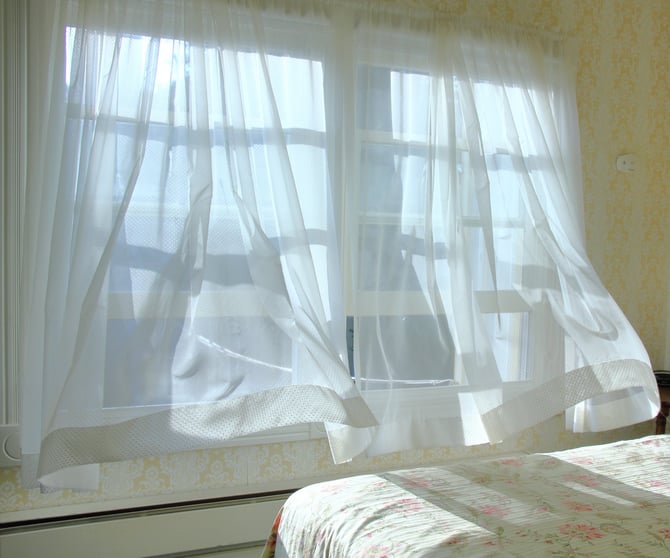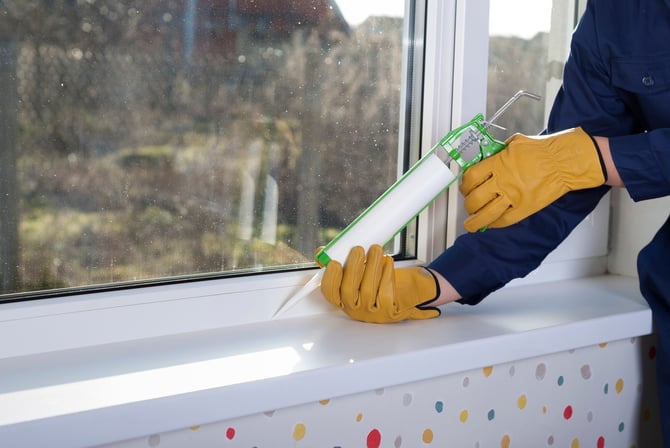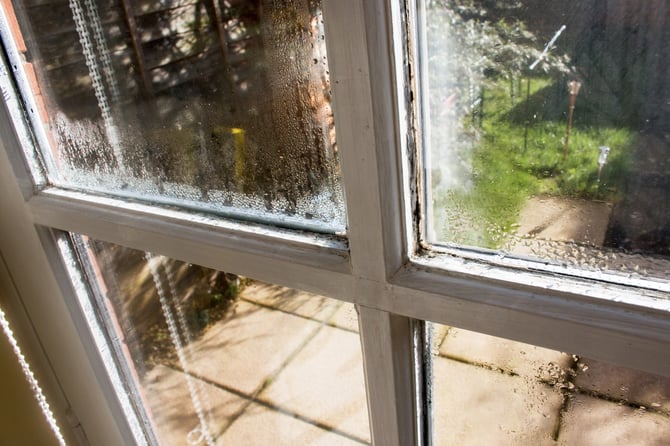Most homeowners face the same conundrum every winter – how to seal window drafts from that cold, brisk air that makes the winter months so unbearable?
If you could only properly seal your old wooden windows – which are the greatest thermal vulnerability of your home – you’d finally be able to enjoy the comfort of a warm house, without having to run up a huge energy bill to heat your interior.
As much as 40 percent of your heat loss can be attributed to uncovered, unsealed, single-pane windows. Wasting energy, ballooning your household’s carbon footprint, and affecting both the comfort and air quality of your indoor environment.
So, what’s the best do it yourself methods to seal drafty windows?
Here’s an in-depth look at all the possible solutions you can try to seal window drafts for the winter. The more you know about how window sealing works, the faster you can get started with the solution that will completely solve your problem.

Window Seal Tape
When dealing with drafts, the key is to close any gaps or cracks around your windows. Whilst small, these cracks can add up to a lot of heat loss, especially in older homes.
Environment Victoria estimates, for the average home, cracks account for anywhere from 15 to 25 percent of your home’s total heat loss. One of the easiest ways to seal some of these cracks is to apply a specialised window seal tape, which you can purchase at your local hardware store, over the edges of your window.
There are a few disadvantages to keep in mind before you stick sealing tape all over your windows.
- This isn’t a good option for windows you may want to open on mild days to let in some fresh air as you’d have to put on new tape.
- When you remove the tape, it may also remove some of the paint around your windows.
- Window tape isn’t remarkably effective, in fact, you may not feel the difference. But, when you need a quick, cheap solution, at least until you have the time to use a better method, it can help, especially if used in conjunction with other drafty window solutions.
Window Weatherstripping
This DIY method is a little more involved than tape, but it’s another inexpensive option for leaking windows. You can seal some of the cracks and gaps on the sides, tops, and bottoms of your window to reduce drafts and stop heat loss.
There are different types of weatherstripping. You can use a vinyl, aluminium or stainless steel V-channel on the sides of your double hung or sliding windows. The downside is, once installed, the material may make it harder to open and close your windows.
Felt weatherstripping will create less resistance when you operate your windows. However, keep in mind, it won’t last for more than a season or two. Also, don’t use felt where there is a lot of moisture as it’s more prone to mould growth. Highly visible, it’s also not the most attractive solution for sealing windows.
Gap Fillers and Putty
For cracks and gaps you can see, you can fill in the open spaces with a filler or putty. There are different products available, such as foam fillers for wider cracks and coloured putty if you want a brown colour to blend in with your wooden window frame.

These fillers won’t completely fix drafty windows, but they can help. Doing an assessment of your home to identify problem areas, you’ll be able to see if there are any open spaces you could fill.
Plastic Window Seal
Another trick is to create an interior window seal with a plastic film, cling wrap, or bubble wrap. One of the most popular DIY window sealing methods for winter is to apply plastic, such as cling wrap, or a special plastic window seal film from a home insulation kit, to your glass with a double-sided tape. Then, use your blow dryer to shrink the plastic over the window.
For bubble wrap, you can spray a mist of water on the glass, and then attach the plastic. The water acts as an adhesive.
Using plastic is not the best way to seal windows for winter as it still leaves the cracks around your windows open to heat loss. Also, plastic doesn’t exactly create a strong barrier for insulating drafty windows. Nor does it do your home’s aesthetics any favours. But, as with other sealing methods, it can help a little until you get a permanent and more powerful method.
The Permanent, Powerful Solution to Seal Wooden Windows
There’s a distinct difference between sealing drafts or insulating the glass to reduce drafts and using a solution that will fix drafty windows for good.
Do you want to know how to seal windows for winter permanently?
With Thermawood’s unique and patented retrofit double glazing process, you get a complete solution. This means you’ll never have to deal with cold drafts again. No more high energy bills from your heating or cooling; double glazed windows help to insulate against unwanted heat gain as well. And, you’ll never have to figure out how to stack your various DIY drafty window solutions every time the cold weather comes, without making your windows look messy.

Isn’t double glazing more expensive than a lot of these cheap sealing options?
A lot of homeowners assume it has to cost a lot of money to double glaze their windows. The truth is, by retrofitting your existing timber windows, you’ll pay about one-third the price of having new double glazed windows installed.
That’s thousands less. Factor that into the time, money, and headache you spend every year trying to figure out the best way to seal windows on your own, and retrofitting starts to make a lot more sense.
Retrofit double glazing also solves your moisture problems.
Normally, moisture forms when your home’s warm, moist air hits the interior window pane’s cold surface – this causes any water vapour in the air to turn into droplets on the glass known as dew point. With a double glazed window, the interior glass is warmer minimising condensation.

Thermawood has taken this one step further by creating a unique process to deal with any moisture on or around your windows. The patented dry glazing design incorporates a full drainage system allowing for the maximum amount of evaporation and rainage, preventing mould growth and rot from happening.

Instead of going through another season of living in a drafty home, dealing with strange-looking plastic covered, taped over, other otherwise altered windows, overpaying on energy bills, and putting your windows at risk for mould growth from moisture build-up, why not fix the problem now?
We see this all the time at Thermawood. A lot of our customers call us in to help after they’ve put themselves through the hassle of various DIY attempts. They are looking for a better solution, one that focuses on longevity and that offers serious results.
Which is what Thermawood’s patented dry Retrofit Double Glazing System provides. Here’s what past customers have said about the difference:
“The house is drier, warmer and a pleasure to get up to in the early mornings at 3am. The guys did a great job…and even impressed the neighbours by the way they worked and cleaned up.”
“[The team] have a great product and fantastic customer service…We wanted to make our old 1970s home as warm and efficient as we could and retrofit double glazing with Thermawood has made all the difference.”
Thermawood knows wooden windows inside and out, and has been approved by Heritage to retrofit Grade 1 and State-Listed properties where every job is a case by case basis. Throughout the installation process a Thermawood franchisee will ensure your windows operate as they should to eliminate drafts, bringing them into the 21st century and performing like new double glazed windows.

[Free Guide]
Learn All About
Keeping The Heat
In or Out of Your Home

![How to Seal Windows? [Insulating Drafty Windows]](https://www.thermawood.co.nz/wp-content/uploads/2021/02/How-to-Seal-Windows-1.png)